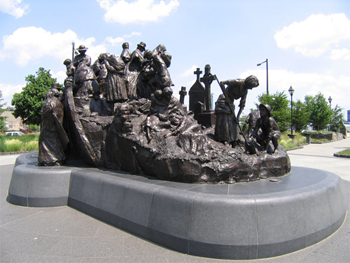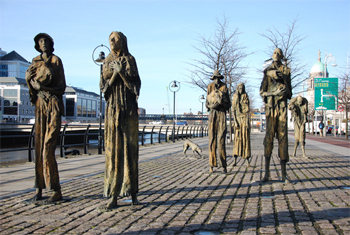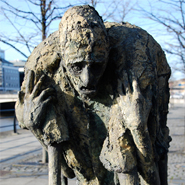Posted 30 January 2014
Tracing the representation of ‘The Great Famine’ through memory and monument
The events of 1845-52 in Ireland known as the ‘Great Famine’ constituted a cataclysm unequalled in Irish history. Drawing on an extensive global survey of recent community and national responses to the anniversary of the Irish Famine, Dr Emily Mark-FitzGerald, UCD School of Art History and Cultural Policy, traces the representation and commemoration of the Irish Famine from the nineteenth century up to its 150th anniversary in the 1990s and beyond.
In a visual cultural history, Dr Mark-FitzGerald explores both popular and official commemorations and outlines why these memories matter and to whom they matter. She argues how the phenomenon of Famine commemoration may be understood in the context of a growing memorial culture worldwide.

Pictured above: Philadelphia Irish Memorial, Penn's Landing, USA. Artist: Glenna Goodacre Irish Memorial, Inc.
“The evocation of emotion has continued to play an essential role in the framing of Famine experiences for a public audience, whether through modern memorials’ meditations on the scale of death and loss (as in Ireland) or figurative/symbolic representations of the emigrant experience (as in the diaspora),” says Dr Mark-FitzGerald in the conclusion to her book Commemorating the Irish Famine: Memory and the Monument.
“It is unquestionable that the intent of most memorials to the Famine is to elicit a deep, personal emotional response to an experience perceived as ‘dormant’ and unacknowledged: a breaking of the ‘silence’ of Famine by the ‘speaking’ of the monument,” she adds.
“The ‘call to remembrance’ voiced by many monuments has been articulated as an opportunity to empathize with the experiences of past forebears, either directly (within the diaspora’s situating of Famine memory within genealogical ties) or at slight remove (within Ireland’s marking of the final resting places of the unnamed dead).”

Picured above and far right: Famine, Custom House Quay, Dublin. Artist: Rowan Gillespie. Commissioned by: Norma Smurfit (donated to Irish government)
“The legacy of the Famine in Ireland and abroad will never be resolved and neatly compartmentalized; nor should it. In an age of globalization and the reduction of complex historical realities into a consumable ‘heritage’, the Famine remains a dislocation whose contradictions outnumber its certainties,” she concludes.
The publication is accompanied by a new online resource www.irishfaminememorials.com.
This online catalogue (a work in progress) showcases some of the research behind the book. The final resource will be a comprehensive guide to contemporary Famine commemoration and the full records pertaining to this research project will be integrated into University College Dublin’s Digital Library in 2014.
Commemorating the Irish Famine: Memory and the Monument by Dr Emily Mark FitzGerald is published by Liverpool University Press.
(Produced by UCD University Relations)

